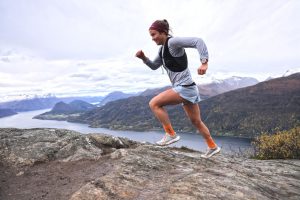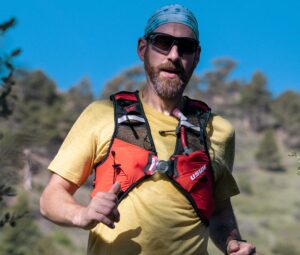
Image courtesy of CamelBak
Most people who compete in an ultramarathon should choose a comfortable and functional hydration vest to wear during the adventure. It’s a matter of both performance and safety, because in the remote and mountainous environments where ultramarathons usually take place, there is so much that can go wrong. And you don’t want to find yourself without water, first-aid, sun and rain protection, or signaling capabilities — all of which are ideal to carry in a hydration vest.
When people talk about ultramarathons, they’re usually referencing races that are 50k or longer, which means it’s not uncommon to spend at least six hours — and sometimes more than 24 hours — out in the woods competing. Weather considerations should factor into your race prep, as should the time of year. What I wear and what want on me at the start line can vary drastically with what I want when I’m four hours into an activity.
Terrain can be one of the biggest issues you encounter in a race: 9,000 feet of elevation gain over 50 miles, with lots of single track and loose rocks? That’s pretty common in my area, so a hydration pack becomes the perfect place to stash a backup pair of socks and some moleskin, especially if there are stream crossings to deal with. A vest often has spots to attach your poles when you’re not using them, and if you have a race with a lot of climbing ahead of you, poles are a good idea!
Most ultramarathons have aid stations that are spaced anywhere from 4 to 8 miles apart. But one I did recently didn’t have its first food-stocked aid station until more than 15 miles in. The race director strongly encouraged runners to carry with them all of the fuel they’d need for the first half of the 50k. My vest pockets were stocked with gels, Honey Stinger wafers, grapes, salt tabs, granola and applesauce. Of note, too: My drink mix of choice is Skratch, so I’ve also got space for several individual packets of that in my vest during a run, since that brand is not available at a lot of races.

Swedish mountain athlete Emelie Forsberg (Image courtesy of COROS)
The right hydration pack for you will have to be one that’s comfortable — chafing can become one of your biggest obstacles if you don’t address it. I prefer having a vest snug enough to where it doesn’t bounce, and the rear storage has to have sufficient ventilation to where my back doesn’t feel like it’s suffocating. Most modern vests have a variety of cinch points, strategic padding and functionality to fine-tune the fit to meet everyone’s unique body shape.
I have seen some highly experienced runners forgo a hydration vest up to 50-milers, but in those instances, they have had a hydration belt or band while also carrying a water bottle in their hand. Even so, this makes me uncomfortable. One of the perks of a vest is that you’re able to keep your hands free (or to use poles), which is helpful for balance and stability on aggressive and technical terrain. Vests also usually have built-in whistles for signaling in case you become injured or are in danger. And there’s so much volume to what can be put in a vest that you can prepare yourself to be away for hours or even multiple days on an adventure.
When looking at hydration vests, you’ll have to decide whether you want to a multi-liter bladder with a drinking hose on your back or if you want to use soft flasks up front (or a combination of the two). I prefer flasks because one can have plain water while the other has a Skratch mix in it. I also feel that a bladder can sometimes create uncomfortable sloshing, but I haven’t done a really long race in the height of summer — my perception may change if I was on an ultra and needed to handle my liquid intake more vigorously.

Vests come in lots and lots of different styles, and it’s certainly best to try one on before buying if you’re able to. At the very least, if you are buying online, choose somewhere that has a very generous return or exchange policy.
Brands like Nathan, Ultimate Direction, UltrAspire and CamelBak have pretty traditionally styled vests. But then there’s Solomon, Uswe, Naked Sports Innovations and Orange Mud that really break the mold in their approach and have designs that you don’t see very often.
If you are looking for your first vest or want to try something new, here are three of our favorites that we’d recommend. They all serve slightly different niches, but they’ve also been put through some pretty major tests during actual ultramarathon conditions:

Image by ECHOS Communications
Uswe Pace 8L
Swedish manufacturer Uswe makes the Pace 8L, which stays secure to your body thanks to a single-clasp “X”-like design on the front. The brand even uses the catchphrase “No Dancing Monkey,” because this vest won’t feel like it’s jumping all over your back and shoulders during a race. It’s also very breathable, and the cinching under the armpits allows for a lot of flexibility on the fly. There’s a perfect zippered pocket at the small of the back for a phone, and there’s plenty of room — both in the secure front pockets and in the main pouch at back — to tackle any long, hard day in the mountains.

Image courtesy of Lucie Hanes
Salomon Sense Pro 10
The Salomon Sense Pro 10 is extremely lightweight and sleek without sacrificing storage space. One runner says she can manage big days or races with a full pack of two flasks, an extra filter bottle, enough fuel for an entire day’s run, multiple outer layers and poles. Without all that gear, it flattens down against her back for short runs, so it’s versatile enough for any kind of outing. It features two small pockets perfect for first aid (ginger chews, caffeine pills, salt tabs, Band-Aids, Vaseline, etc.) and two bigger zippered pockets for my phone, headphones, keys, and other such valuables. The fabric is also very soft against the skin, so it doesn’t chafe.

Image courtesy of Tara Dower, Long Creek 60k
Naked High Capacity Running Vest
Naked Sports Innovations delivers one of the most unique packs on the market — one that’s involves very specific sizing and a compression fitting that takes some getting used. But once you are used to it, wow! It honestly feels like a second skin … you know, kinda like you’re naked. The HC Running Vest zips in the front, so it’s easy to pop on and off if you need to reach the back pouch. Overall, it has 3 liters of carrying capacity, which is enough for front flasks and some small food items. On this vest, nothing goes to waste, and there’s even taut compression pockets underneath the arms. And, wonderfully, Naked has a great exchange policy and will work with you to find you just the right fit.
 Your Privacy Choices
Your Privacy Choices
 The
The